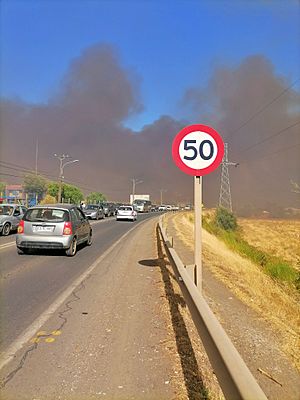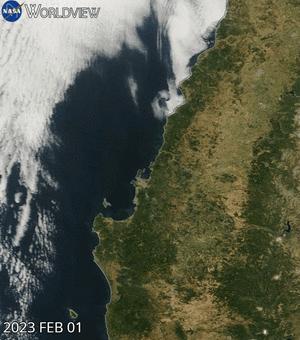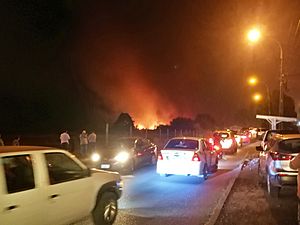2023 Chile wildfires facts for kids
Quick facts for kids 2023 Chile wildfires |
|
|---|---|

Burn scars left from the outbreak of wildfires in Chile from January to February 2023
|
|
| Location | |
| Statistics | |
| Total fires | 407 (256 active, 151 contained as of 18 February) |
| Total area | 430,000 hectares (1,100,000 acres) |
| Date(s) | 30 January 2023–20 February 2023 |
| Cause | Heatwaves, drought, suspected arson |
| Buildings destroyed | 1,180+ homes destroyed |
| Deaths | 26 |
| Non-fatal injuries | 2,180 |
In early 2023, many large wildfires started in Chile, a country in South America. These fires began on January 30, 2023. By February, there were over 400 separate fires. Many were so serious they were called "red alert fires".
These fires burned over 430,000 hectares (1,100,000 acres) of land. Sadly, 24 people lost their lives. The government had to declare a state of emergency in several areas.
Contents
What Caused the Wildfires?
Chile has been very dry since 2010. This long dry period is called a megadrought. It is the worst drought in a thousand years. Dry plants and trees catch fire easily, making summer fires much worse.
Since January 30, 2023, the Ñuble area had an early warning for forest fires. This was because of very high temperatures. The fires happened during a record-breaking heat wave in southern Chile. Temperatures reached 40 degrees Celsius (104 degrees Fahrenheit) in some southern areas.
René Garreaud, a scientist from the University of Chile, explained why it was so hot. He said warm winds called Puelche winds blew from the east. These winds, combined with a warmer climate, made temperatures extremely high.
Some people were arrested for possibly starting fires. This could have happened from activities like welding or burning wool.
Climate Change and Drought
The wildfires might have been started by people. But the main reason they were so bad was the ongoing drought. This drought is linked to climate change and a Pacific weather pattern called La Niña.
South America has always had droughts. However, Chile is especially at risk from extreme weather. This includes changes in seasons, wildfires, and rising sea levels. Poor planning of land use has also made it easier for fires to spread.
In August 2022, Christián Little from the National Forest Corporation (CONAF) warned about a high risk of large, many fires. This was expected between October 2022 and January 2023. He explained that a lot of rain in 2022 caused a lot of grass to grow. This grass could easily burn in the dry season. CONAF gave an even more serious warning in January 2023.
CONAF believes that about 41% of the wildfires in the Ñuble, Biobío, and Araucanía regions were started by people on purpose. This was between July 2022 and February 2023. Across the whole country, about 25% of wildfires were thought to be intentional.
Fire Spread and Forestry
Officials mentioned that some fires might have spread by animals like rabbits-on-fire. However, experts doubt this is a major way fires spread. Rabbits would likely only move a short distance before stopping or dying.
As of February 18, 2023, 256 fires were still burning. Another 151 fires were under control. After a short break, fires started again on February 18 in south-central Chile. By February 20, 173 fires were put out, but 70 were still active.
Experts have also pointed to human and political reasons for the fires that often hit Chile. In 1974, a government decision encouraged planting many eucalyptus trees. These trees catch fire very easily.
The group Bosque Nativo says there are problems with how these tree farms are managed. Most of them are owned by two big companies. They say there is not enough control over these companies. This would help make sure the tree farms are managed in a way that is good for the economy, people, and the environment.
People are also asking for rules about building on burnt land. President Gabriel Boric has asked lawmakers to quickly look at a plan. This plan would stop building on burnt land for at least 30 years.
In 2017, central and southern Chile also had very large fires. Eleven people died, and 467,000 hectares burned. After those fires, a report in 2020 suggested rules for the tree farming industry. It said that with climate change making fires worse, it is important to control non-native trees like pines and eucalyptus. It also said that restoring native plants could help reduce big fires.
Impacts of the Fires
People Affected
The Chilean government reported that at least 24 people died from the wildfires. Eleven of these deaths were in the town of Santa Juana. Two other deaths happened when an emergency helicopter crashed. This killed its pilot and a mechanic. A firefighter also died after being hit by a truck while working. At least three people were badly hurt by a fire on February 18.
Damage to Homes and Land
The fires destroyed at least 800 homes. Almost 300,000 hectares of land burned in the Maule, Ñuble, Biobío, and Araucanía regions.
The smoke from the fires made the air quality much worse in affected areas. On February 7, 2023, smoke even reached the capital city, Santiago.
A large paper company in Chile, CMPC, said that over 10,000 hectares of its tree farms were affected. Some of its factories also had to stop working. Another company, Arauco, estimated a $50 million loss because of the fires.
Firefighting Efforts
About 5,600 firefighters and volunteers worked to fight the fires in many regions. A large DC-10 air tanker from the United States arrived to help. This plane can drop 36,000 liters (about 9,500 gallons) of water. In Chile, professional firefighters called "brigadistas" fight forest fires. Other firefighters, who fight city fires, are all volunteers.
Many countries sent help to Chile to fight the wildfires:

- Argentina: Sent 40 firefighters, 15 trucks, and a helicopter.
- Brazil: Provided support with firefighters.
- Colombia: Sent a plane and a group of people to put out fires.
- Ecuador: Provided support with firefighters.
- Spain: Sent an A330 plane and 50 firefighters.
- United States: Gave 50 thousand dollars in financial help.
- Mexico: Sent two military planes with about 300 volunteers.
- Peru: Sent several helicopters to fight fires.
- Venezuela: Sent 60 firefighters.
- European Union: Sent over 250 firefighters, coordinators, and medical staff.
See also
 In Spanish: Incendios forestales en Chile de 2023 para niños
In Spanish: Incendios forestales en Chile de 2023 para niños
- 2012 Araucanía wildfires
- 2017 Chile wildfires
- 2021 Argentine Patagonia wildfires
- Great Fire of Valparaíso
- List of wildfires





